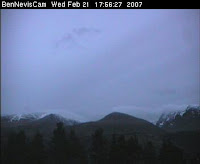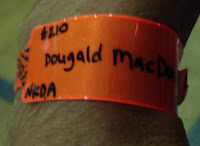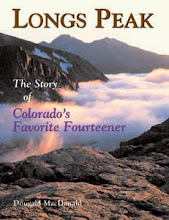 I'm headed to Scotland this weekend for the BMC International Winter Meet (aka the International Slogging and Sleet Fest): 40-plus climbers from 23 countries, plus British hosts, gathering for a week of Scottish mixed climbing. You can't see much from this afternoon's Ben Nevis webcam (typical), but conditions haven't been too great recently. Still, we'll get out and do what we can. I probably won't have time to post much here about the trip, but look for daily reports on the meet and the climbing at Climbing.com, starting on Monday.
I'm headed to Scotland this weekend for the BMC International Winter Meet (aka the International Slogging and Sleet Fest): 40-plus climbers from 23 countries, plus British hosts, gathering for a week of Scottish mixed climbing. You can't see much from this afternoon's Ben Nevis webcam (typical), but conditions haven't been too great recently. Still, we'll get out and do what we can. I probably won't have time to post much here about the trip, but look for daily reports on the meet and the climbing at Climbing.com, starting on Monday.
Wednesday, February 21, 2007
Rime and Punishment
Posted by
Dougald MacDonald
at
11:43 AM
1 comments
![]()
![]()
Tuesday, February 20, 2007
More Fun with Climbing Communication
So, my wife and I were climbing in Joshua Tree with some friends, and I ended up on top of a pinnacle as she was finishing a different climb on the same spire. As she struggled a bit with the crux moves, about 20 feet below me, she muttered, "Maybe I should just take up golf." Now, it was quite windy on top, and what I heard was, "Maybe I should just take a fall." I thought she might be considering jumping off to clear her head. This was the exchange that resulted:
She: "Maybe I should just take up golf."
Me: "Maybe you should, honey."
[Slight pause]
She: "Maybe you should shut the fuck up!"
Me [puzzled and hurt]: "What did I say?"
Outcome: She finished the climb with no problem, and we all had a good laugh. I'm a lucky guy, in fact, because my wife and I climb (and communicate) quite well together.
For those who missed it, check out the story of this unhappy couple's poor climbing communication.
Posted by
Dougald MacDonald
at
9:53 AM
0
comments
![]()
![]()
Thursday, February 15, 2007
Now We're Talking!
 Big-wall climbers: Your days of exhausting jumaring up fixed lines are over! The Atlas Rope Ascender will lift a 250-pound load more than 600 feet on a single battery charge, at up to 10 feet per second. Why climb when you can ride? Rig this puppy at an anchor and hauling will be as simple as flipping the on switch. Just be ready to kill the motor when the bag snags on a roof, or you'll be spraying the talus with cans of Olde English 800.
Big-wall climbers: Your days of exhausting jumaring up fixed lines are over! The Atlas Rope Ascender will lift a 250-pound load more than 600 feet on a single battery charge, at up to 10 feet per second. Why climb when you can ride? Rig this puppy at an anchor and hauling will be as simple as flipping the on switch. Just be ready to kill the motor when the bag snags on a roof, or you'll be spraying the talus with cans of Olde English 800.
Posted by
Dougald MacDonald
at
6:30 AM
2
comments
![]()
![]()
Wednesday, February 14, 2007
Trans-Rockies Run
 Man, if I were running these days like I did in 2005, when I tried the Leadville 100.... The Gore-Tex Trans-Rockies Run looks like an amazing event, modeled on the multiday alpine stage races in Europe. In the inaugural event in September, up to 150 teams of two racers will run from Beaver Creek, Colorado, to Aspen: six days on trails, forest roads, and pavement, totaling about 125 miles, camping each night at a tent city set up and torn down by the race staff. The course:
Man, if I were running these days like I did in 2005, when I tried the Leadville 100.... The Gore-Tex Trans-Rockies Run looks like an amazing event, modeled on the multiday alpine stage races in Europe. In the inaugural event in September, up to 150 teams of two racers will run from Beaver Creek, Colorado, to Aspen: six days on trails, forest roads, and pavement, totaling about 125 miles, camping each night at a tent city set up and torn down by the race staff. The course:
Stage 1: Beaver Creek to Camp 1, 10-15 miles, 2,500-3,000 feet
Stage 2: Camp 1 to Camp 2, 25-29 miles, 6,000-6,500 feet
Stage 3: Camp 2 to Leadville, 15-19 miles, 1,700-2,200 feet
Stage 4: Leadville to Camp 3, 24-28 miles, 3,500-4,000 feet
Stage 5: Camp 3 to Camp 4, 16-20 miles, 3,500-4,000 feet
Stage 6: Camp 4 to Aspen, 22 – 26 miles, 6,000-7,000 feet
I suppose if I ever were going to train for one mountain stage race, it would be the Ultra-Trail Tour du Mont Blanc, 163 kilometers around Europe's iconic Alpine summit. But this new race looks darn good!
Posted by
Dougald MacDonald
at
6:30 AM
3
comments
![]()
![]()
Saturday, February 10, 2007
Ephemera
This has been an unusual and fantastic season for ice climbing along Colorado's Front Range, as heavy snows and persistent cold brought numerous rare visitors into condition and even allowed some new discoveries. This week temperatures climbed into the 60s, and the best of the new climbs all vanished. But it was a treat while they were here. I got a late start and missed some of the early action, including some cool-looking steep verglas climbs along summertime sport routes, right by the road in South St. Vrain Canyon.
But when word got out that a significant new climb had been done in Deadman Gulch, Greg Sievers and I got out there and bagged probably the third or fourth ascent of Dead Men Chipping, a beautiful 175-foot smear of golden ice discovered by Bernard Gillett, who climbed it with Topher Donahue. Nothing but stubbies and a few rock pieces on this one. Greg and I then peeked around the corner to the right and found an even thinner line up a vague groove system, which Greg led in a 200-foot pitch, with some serious mixed climbing and steep ice. We shattered some key ice at the second crux, and subsequent ascents have had to do some offwidth moves in a crack on the right side of the groove—not your usual ice-climbing moves. Greg called it Vrain Strain.
The Flatirons above Boulder have been climbed in winter for decades. I did two nice three-pitch routes almost 20 years ago on the Goose and an unnamed formation on the east side of Bear Peak. (The latter comes in almost every November or December, but it's a long walk!) These low-angle, thin, and scratchy climbs are really fun alpine simulators.This year an old climb called Silk Road came into superb shape on the First Flatiron, just 30 minutes from the trailhead. I climbed it one evening, escaping where it bumped into the First's North Ridge by climbing a tree to the ridge; roped parties sometimes continued up a short steep pillar and mixed climbing all the way to the summit—something like 1,000 feet of mixed climbing, overlooking the city of Boulder. Not bad!

 Last Monday night, a friend and I talked about doing Mouse-Ka-Teers, a multipitch WI4 on the back side of the Mickey Mouse Wall, high above Eldorado Canyon. But Monday had been in the 50s, with a strong wind, and the forecasted high for the next day was even warmer. I demurred. However, someone went up there that morning and later posted this pair of photos on Mountain Project: the first was taken at 7 a.m., the second around noon. They barely got away with it!
Last Monday night, a friend and I talked about doing Mouse-Ka-Teers, a multipitch WI4 on the back side of the Mickey Mouse Wall, high above Eldorado Canyon. But Monday had been in the 50s, with a strong wind, and the forecasted high for the next day was even warmer. I demurred. However, someone went up there that morning and later posted this pair of photos on Mountain Project: the first was taken at 7 a.m., the second around noon. They barely got away with it!
And so, unless we get another big dump of snow and a cold snap, the lowland climbing is over for the year. Back to the mountains we go.
Posted by
Dougald MacDonald
at
8:03 AM
0
comments
![]()
![]()
Friday, February 09, 2007
Web vs. Print II
"I really don't know whether we'll be printing the Times in five years, and you know what? I don't care, either."
That was New York Times Publisher Arthur Sulzberger, speaking to a reporter from the Israeli news organization Haaretz. Sulzberger went on to say that the Times has far more daily online readers than print subscribers (1.5 million vs. 1.1 millon), and that the average age of its online readers is five years younger than its print readers. Sulzberger argues that the Times can make just as much money online as in newsprint, even if the ads generate less revenue, because Internet advertising doesn't require the huge printing and distribution costs of newspapers. And don't expect to keep reading the Times online for free, as I do every morning. If you want the Times, you'll soon have to pay for it online, just as you would if you were buying a paper.
That said, radio and TV didn't kill off print media, and I doubt the Internet will, either. At least not for a while. Worldwide, newspaper circulation grew 10 percent between 2001 and 2005.
I'm no Nostradamus, but if I had to guess how the print vs. web balance will shift in the next 10 years, I'd say printed news and opinion will move almost exclusively to the web, which allows all the advantages of continuous updates and interactivity. So will some sports event coverage: I almost wore out my index finger clicking for updates on the 24 Hours of Sunlight, at which Greg Hill came up just short of 50,000 vertical feet of uphill and downhill skiing last weekend. (Three different skiers, including Hill, did break 40,000 feet!) Cookbooks, climbing guidebooks, and other how-to, where-to books also will move toward the Web—I already search and print out more new recipes than ones I look up in a cookbook; I still carry a guidebook to the crag, but I usually update it each day I go climbing with a printout from Mountain Project. On the other hand, books that involve real reading—fiction, history, biography—and those that feature big, beautiful pictures will continue to be printed on paper for many, many years, no matter how many new gizmos are invented for taking electronic books to the beach. The advantages and satisfactions of a printed book are just too many. Ditto for magazines, which is where this discussion started. News and how-to magazines may all move online, but those that print long, thoughtful articles or big, beautiful pictures (not to mention high-impact glossy advertising) will continue to thrive in print, just as books will.
Alright, enough of this. Back to the mountains.
Posted by
Dougald MacDonald
at
6:21 AM
2
comments
![]()
![]()
Tuesday, February 06, 2007
Web vs. Print
 A single thread ran through most of the comments on my recent post about the economics of climbing magazines: the idea that print media is on its way out, and the Internet soon will rule. And so it's interesting to note that 8a.nu, the Swedish web site that has become the international clearinghouse for sport-climbing and bouldering news—likely the No. 1 international climbing site in traffic and reigstered membership—is about to publish....wait for it....a magazine. Actually, it's an annual, but still, it's going to be printed on old-fashioned paper.
A single thread ran through most of the comments on my recent post about the economics of climbing magazines: the idea that print media is on its way out, and the Internet soon will rule. And so it's interesting to note that 8a.nu, the Swedish web site that has become the international clearinghouse for sport-climbing and bouldering news—likely the No. 1 international climbing site in traffic and reigstered membership—is about to publish....wait for it....a magazine. Actually, it's an annual, but still, it's going to be printed on old-fashioned paper.
UPDATE: 8a announced Wednesday that it has received sponsorship to double the print run of its yearbook, to 10,000.
Posted by
Dougald MacDonald
at
6:26 AM
4
comments
![]()
![]()
Friday, February 02, 2007
1,000,000-Plus
 In 2004-05, Greg Hill from B.C. climbed and skied 1 million vertical feet (up and down, earning turns the whole way) in 145 skiing days, averaging a little under 7,000 vertical feet per day. Do a little mental exercise and imagine your favorite backcountry tour or ski resort, and then imagine climbing 7,000 vertical feet there. Now try to imagine doing it for 145 days. (Some days were much bigger: Hill's topper that season was over 40,000 feet in a day.) Amazing. So what does he do next? Raise the stakes.
In 2004-05, Greg Hill from B.C. climbed and skied 1 million vertical feet (up and down, earning turns the whole way) in 145 skiing days, averaging a little under 7,000 vertical feet per day. Do a little mental exercise and imagine your favorite backcountry tour or ski resort, and then imagine climbing 7,000 vertical feet there. Now try to imagine doing it for 145 days. (Some days were much bigger: Hill's topper that season was over 40,000 feet in a day.) Amazing. So what does he do next? Raise the stakes. This season, the aptly named Hill is trying to climb and ski at least 10,000 vertical feet for 100 days. Ai-yi-yi! On Saturday, he should get a major boost to the ol' average. Hill will race in the 24 Hours of Sunlight in western Colorado, where, last year, he and partner Jimmy Faust climbed and skied 50,100 feet in 24 hours. With lighter skis and a refined game plan, Hill is gunning for more this year. If he has a goal, he's not saying, but it's likely to be huge.
This season, the aptly named Hill is trying to climb and ski at least 10,000 vertical feet for 100 days. Ai-yi-yi! On Saturday, he should get a major boost to the ol' average. Hill will race in the 24 Hours of Sunlight in western Colorado, where, last year, he and partner Jimmy Faust climbed and skied 50,100 feet in 24 hours. With lighter skis and a refined game plan, Hill is gunning for more this year. If he has a goal, he's not saying, but it's likely to be huge.
Check out Greg Hill's blog of his ski outings for inspirational photos and fun accounts of what it's like to ski BIG. Enjoy, but don't try to understand.
Posted by
Dougald MacDonald
at
6:49 AM
1 comments
![]()
![]()







